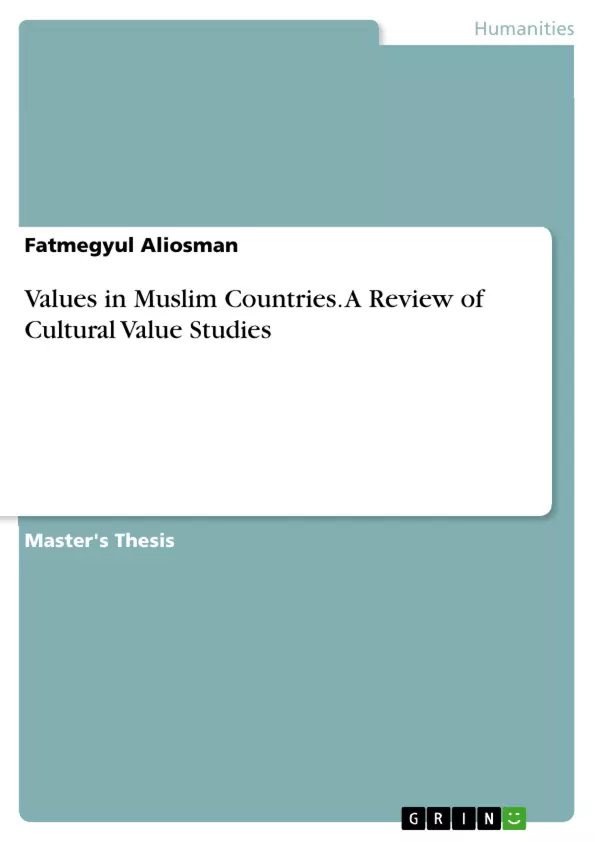The objective of this thesis is to understand whether Muslim groups have any shared values which are distinct from other groups and to understand what cultural values the Muslim groups possess. Like any other religion, Islam influences societies’ cultures of which it is the dominant faith. However, this research aims to understand whether it has a major cultural effect so that Muslim groups can be distinguished from other religions’ groups on the basis of cultural values.
Besides, it is also important to understand whether all Muslim groups share the same values when regional or climate effects are controlled for. House et al. (2004) state that region has influence on cultural values of societies. Climate also has effect on cultural even though it is not significant as regional influence.
Another objective of this research is to identify whether there are value differences between Shia and Sunni branches of Islam. Sunni faith is based on following Prophet Muhammad’s example path and rules described in Koran. In contrast, Shia faith is based on the path of Prophet Muhammad and his direct family members’ religious and spiritual teachings (Farah and Samad, 2015).
Inhaltsverzeichnis (Table of Contents)
- Introduction
- Problem setting
- Objective
- Structure of the thesis
- Value Theory
- The Definition of Value
- Human Values and Cultural Values
- Conceptual framework of major value studies
- Rokeach
- Hofstede
- Inglehart World Value Survey
- Schwartz
- The GLOBE Study
- Comparison
- Comparison of studies – different classification systems
- Particular issues of Muslim values
- Conclusion for the research
- Method
- Methodologies of major value studies
- Hofstede
- Inglehart - World Value Survey
- Schwartz
- The Globe Study
- Countries covered
- Methodologies of major value studies
- Results (supported by relevant research papers)
- Hofstede
- Inglehart - World Value Survey
- Schwartz
- The Globe Study
- Discussion
- Summary
Zielsetzung und Themenschwerpunkte (Objectives and Key Themes)
This master thesis aims to provide a comprehensive overview of cultural value studies in Muslim countries. It delves into the theoretical framework of value theory, analyzes prominent studies such as Hofstede, Inglehart World Value Survey, Schwartz, and GLOBE, and examines their findings in relation to Muslim cultural values. The thesis aims to offer a nuanced understanding of the values prevalent in Muslim societies and their implications for various aspects of social and economic life.
- The definition and conceptualization of values in cultural contexts.
- A comparative analysis of major value studies and their applicability to Muslim societies.
- The identification of key values prevalent in Muslim countries.
- The impact of these values on social and economic development.
- The potential for further research on Muslim values.
Zusammenfassung der Kapitel (Chapter Summaries)
The introduction lays the groundwork for the thesis, outlining the research problem, objective, and structure. Chapter 2 delves into the theoretical framework of value theory, exploring the definition of value, distinguishing between human and cultural values, and examining major value studies like Hofstede, Inglehart, Schwartz, and GLOBE. The chapter concludes with a comparison of these studies, highlighting their different classifications and addressing particular issues related to Muslim values. Chapter 3 focuses on the methodology employed in major value studies, providing an in-depth look at the research methods used by Hofstede, Inglehart, Schwartz, and the GLOBE Study. It also specifies the countries covered in these studies. Chapter 4 presents the results of the research, supported by relevant research papers. It examines findings from Hofstede, Inglehart, Schwartz, and GLOBE studies, highlighting key values prevalent in Muslim societies. Chapter 5 engages in a discussion of the research findings, analyzing their implications and drawing conclusions about the relationship between values and social and economic development in Muslim countries.
Schlüsselwörter (Keywords)
The key focus topics of this research include: cultural values, Muslim societies, value studies, Hofstede, Inglehart World Value Survey, Schwartz Value Survey, GLOBE Study, cross-cultural comparison, social and economic development, Muslim values.
- Citation du texte
- Fatmegyul Aliosman (Auteur), 2015, Values in Muslim Countries. A Review of Cultural Value Studies, Munich, GRIN Verlag, https://www.grin.com/document/312642



